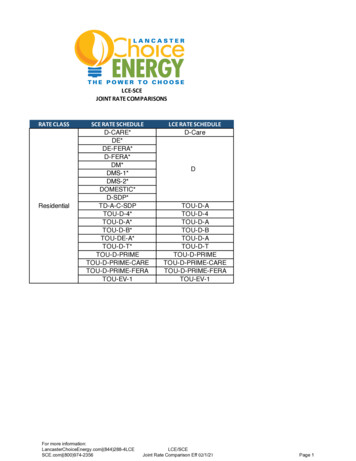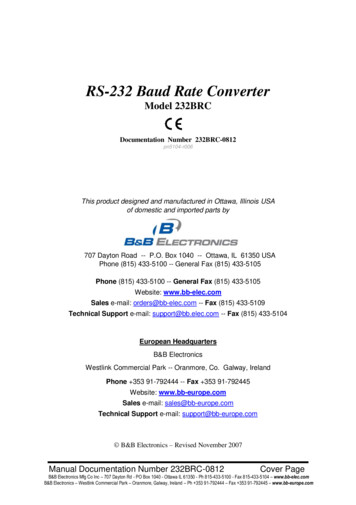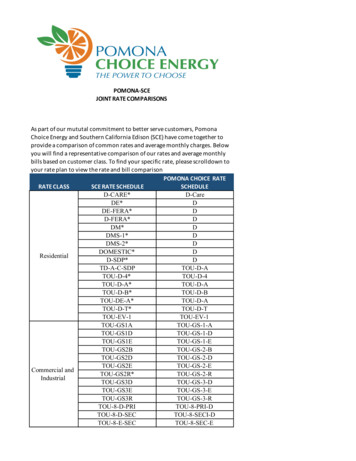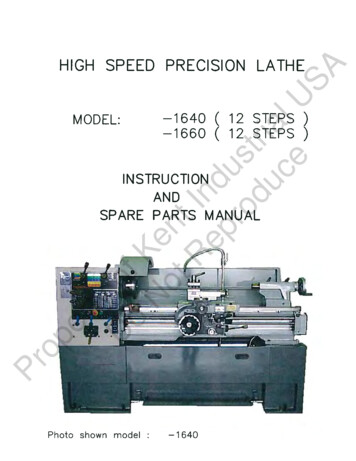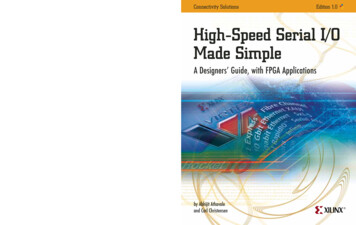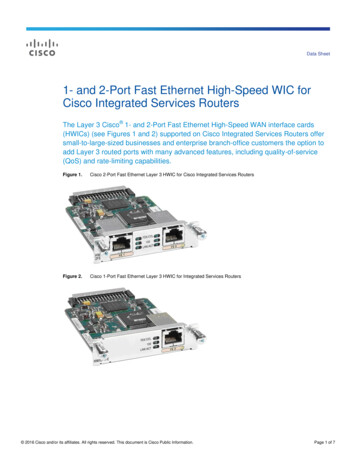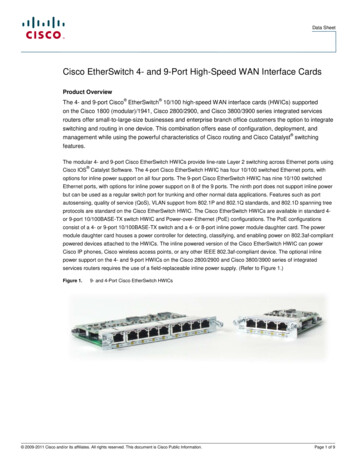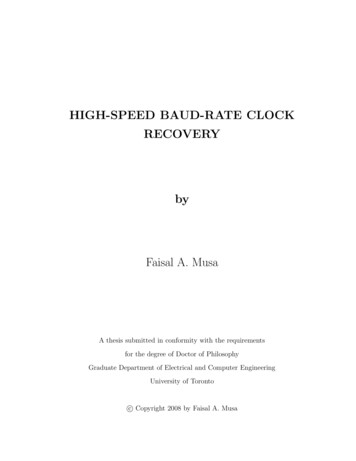
Transcription
HIGH-SPEED BAUD-RATE CLOCKRECOVERYbyFaisal A. MusaA thesis submitted in conformity with the requirementsfor the degree of Doctor of PhilosophyGraduate Department of Electrical and Computer EngineeringUniversity of Torontoc Copyright 2008 by Faisal A. Musa
ii
iiiHIGH-SPEED BAUD-RATE CLOCK RECOVERYFaisal A. MusaDoctor of Philosophy, 2008Graduate Department of Electrical and Computer EngineeringUniversity of TorontoAbstractBaud-rate clock recovery (CR) is gradually gaining popularity in modern serial datatransmission systems since these CR techniques do not require edge-samples for extractingtiming information. However, previous baud-rate techniques for high-speed serial linkseither rely on specific 4-bit patterns or uncorrelated random data. This work describesthe modeling and design of analog filter front-end aided baud-rate CR schemes. Unlikeother baud-rate schemes, this technique is not constrained by the properties of the inputrandom data.Firstly, the thesis develops a hardware-efficient baud-rate algorithm that requires onlythe slope information of the incoming random data. Called modified sign-sign minimummean squared error (SSMMSE), this algorithm adjusts the clock sampling phase untilthe slope is zero through a bang-bang control loop. Secondly, the performance of amodified SSMMSE phase detector is investigated and compared with a conventional edgesampled phase detector. It is shown that, at severe noise levels, the proposed modifiedSSMMSE method has better performance compared to the edge-sampled method forequal loop bandwidths.Thirdly, the thesis investigates different hardware-efficient slopedetection techniques. Both passive and active filter based slope detection techniques aredemonstrated in this work. In addition to slope generation, the active filter performslinear equalization as well. However, the passive filter generates the slope information athigher speeds than the active filter and also consumes less power. The two filters are usedto recover a 2-GHz clock by using an external bang-bang loop.In short, the thesis demonstrates that area and power savings can be achieved byutilizing slope information from front-end filters without compromising the performanceof the CR unit.
ivAcknowledgmentsI would like to thank my supervisor, Professor Anthony Chan Carusone for providingme with the opportunity to do research with him. His insight, deep understanding andelegant personality has motivated me over the years and has greatly contributed to thecompletion of this project. Professor Carusone has believed in me even during the mostdifficult of times and has provided me with much needed support and encouragement. Hehas my sincerest thanks and deepest gratitude.I would also like to thank Professor David Johns and Professor Sorin Voinigescu forbeing on my committee and for providing me with valuable comments. Their commentshave greatly improved the quality of this thesis.Special thanks to all my wonderful and inspiring friends in Tony’s group. I would alsolike to thank all my peers in the Electronics group at U of T. I would also like to gratefullyacknowledge the support of CMC, Intel and Gennum.Finally, my parents have inspired me from a very early age and have provided mewith valuable guidance. They have my deepest respect and gratitude. I would also liketo thank my wife, Rashida and son Ryan for their support and patience throughout thisproject.
ContentsAbstract . . . . . . . . . . . . . . . . . . . . . . . . . . . . . . . . . . . . . . . .iiiAcknowledgments . . . . . . . . . . . . . . . . . . . . . . . . . . . . . . . . . . .iv1 Introduction31.1Motivation . . . . . . . . . . . . . . . . . . . . . . . . . . . . . . . . . . . .31.2Overview of different Baud-Rate CDR techniques . . . . . . . . . . . . . .81.2.1Integrating front-end based baud-rate clock recovery. . . . . . . .81.2.2Mueller-Muller PD based CDR . . . . . . . . . . . . . . . . . . . .91.2.3Minimum mean squared error (MMSE) PD based CDR . . . . . . . 111.2.4Choice of baud-rate MMSE CDR . . . . . . . . . . . . . . . . . . . 111.31.4MMSE PD schemes for high-speed serial links . . . . . . . . . . . . . . . . 121.3.1Review of published MMSE schemes . . . . . . . . . . . . . . . . . 121.3.2Sign-Sign MMSE (SSMMSE) . . . . . . . . . . . . . . . . . . . . . 131.3.3Modified SSMMSE . . . . . . . . . . . . . . . . . . . . . . . . . . . 151.3.4Effect of zero-ISI channel . . . . . . . . . . . . . . . . . . . . . . . . 171.3.5High-speed slope detection . . . . . . . . . . . . . . . . . . . . . . . 18Organization of the thesis . . . . . . . . . . . . . . . . . . . . . . . . . . . 202 Analysis and modeling of bang-bang CDRs2.121Introduction . . . . . . . . . . . . . . . . . . . . . . . . . . . . . . . . . . . 212.1.1Background . . . . . . . . . . . . . . . . . . . . . . . . . . . . . . . 212.1.2Chapter Outline . . . . . . . . . . . . . . . . . . . . . . . . . . . . . 232.2Concept of linearizing a bang-bang loop. . . . . . . . . . . . . . . . . . . 232.3Stochastic Modeling of CDR input . . . . . . . . . . . . . . . . . . . . . . 262.3.1Effect of channel response . . . . . . . . . . . . . . . . . . . . . . . 272.3.2Additive Noise . . . . . . . . . . . . . . . . . . . . . . . . . . . . . 30v
viCONTENTS2.3.32.42.52.6System Level Parameters . . . . . . . . . . . . . . . . . . . . . . . . 30Multilevel CDR architectures . . . . . . . . . . . . . . . . . . . . . . . . . 322.4.1Alexander PD-based CDR . . . . . . . . . . . . . . . . . . . . . . . 322.4.2SSMMSE PD-based CDR . . . . . . . . . . . . . . . . . . . . . . . 39Effect of system non-idealities . . . . . . . . . . . . . . . . . . . . . . . . . 452.5.1Effect of channel bandwidth . . . . . . . . . . . . . . . . . . . . . . 452.5.2Effect of SNR . . . . . . . . . . . . . . . . . . . . . . . . . . . . . . 482.5.3Effect of VCO Jitter . . . . . . . . . . . . . . . . . . . . . . . . . . 492.5.4Effect of Transmitter Jitter. . . . . . . . . . . . . . . . . . . . . . 49Conclusion . . . . . . . . . . . . . . . . . . . . . . . . . . . . . . . . . . . . 493 A Passive Filter Aided Timing Recovery Scheme533.1Introduction . . . . . . . . . . . . . . . . . . . . . . . . . . . . . . . . . . . 533.2Background . . . . . . . . . . . . . . . . . . . . . . . . . . . . . . . . . . . 543.3Design and Implementation of Passive Filter . . . . . . . . . . . . . . . . . 543.43.3.1Topology . . . . . . . . . . . . . . . . . . . . . . . . . . . . . . . . . 543.3.2Modeling and Analysis . . . . . . . . . . . . . . . . . . . . . . . . . 573.3.3Measurement Results . . . . . . . . . . . . . . . . . . . . . . . . . . 60Design and implementation of external timing recovery loop . . . . . . . . 613.4.13.53.6Measurement Results . . . . . . . . . . . . . . . . . . . . . . . . . . 69Half-Rate Modified SSMMSE PD based CDR . . . . . . . . . . . . . . . . 723.5.1Proposed Half-Rate PD architecture . . . . . . . . . . . . . . . . . 723.5.2Simulation Results . . . . . . . . . . . . . . . . . . . . . . . . . . . 73Conclusion . . . . . . . . . . . . . . . . . . . . . . . . . . . . . . . . . . . . 794 Dual-Function Analog Filter Aided Timing Recovery814.1Overview . . . . . . . . . . . . . . . . . . . . . . . . . . . . . . . . . . . . . 814.2Background . . . . . . . . . . . . . . . . . . . . . . . . . . . . . . . . . . . 824.3Dual-Function Analog Filter . . . . . . . . . . . . . . . . . . . . . . . . . . 824.4Measurement Results . . . . . . . . . . . . . . . . . . . . . . . . . . . . . . 874.4.1Frequency Response . . . . . . . . . . . . . . . . . . . . . . . . . . 894.4.2Slope Detection . . . . . . . . . . . . . . . . . . . . . . . . . . . . . 894.4.3Noise Figure Measurement . . . . . . . . . . . . . . . . . . . . . . . 894.4.4Linear Equalization . . . . . . . . . . . . . . . . . . . . . . . . . . . 93
CONTENTSvii4.4.5Timing Recovery . . . . . . . . . . . . . . . . . . . . . . . . . . . . 934.5Conclusion . . . . . . . . . . . . . . . . . . . . . . . . . . . . . . . . . . . . 1015 Conclusion1035.1Summary and Future Work . . . . . . . . . . . . . . . . . . . . . . . . . . 1035.2Contributions of this work . . . . . . . . . . . . . . . . . . . . . . . . . . . 1065.3Publications arising from this thesis . . . . . . . . . . . . . . . . . . . . . . 106A Joint PDF for the SSMMSE PD109B Inductor Models for passive filter113C AD8343 Mixer Matching Network117
viiiCONTENTS
List of Figures1.1Blockdiagram of typical serial link . . . . . . . . . . . . . . . . . . . . . . .31.2Classification of CMOS clock recovery schemes. . . . . . . . . . . . . . . .41.3Inductive PD schemes. (a) Linear (e.g. Hogge PD). (b) Non-linear (e.g.Alexander PD). . . . . . . . . . . . . . . . . . . . . . . . . . . . . . . . . .1.4Timing diagrams for two nonlinear inductive CDRs (a) Edge-sample (orAlexander) PD based CDR. (b) Baud-rate PD based CDR.1.5. . . . . . . .6Block diagrams for half-rate CDRs. (a) Edge-sample (or Alexander PD)based CDR. (b) Baud-rate CDR. . . . . . . . . . . . . . . . . . . . . . . .1.656Extracting timing information from a noisy eye with two different frontends. (a) Front-end consisting of an ADC and digital equalizer. (b) Frontend consisting of a decision circuit and DFE. . . . . . . . . . . . . . . . . .1.7Integrating front-end based baud-rate clock recovery (a) Block diagram.(b) Timing diagram. . . . . . . . . . . . . . . . . . . . . . . . . . . . . . .1.878Principle of Mueller-Muller (MM) timing recovery. (a) Concept of obtaining timing information from the pulse response. (b) Block diagram. . . . . 101.9Typical block diagram of MMSE timing recovery that uses a 2-tap slopedetector. . . . . . . . . . . . . . . . . . . . . . . . . . . . . . . . . . . . . . 121.10 Slope estimation using a two-tap filter. . . . . . . . . . . . . . . . . . . . . 131.11 Block diagram of sign-sign MMSE (SSMMSE). . . . . . . . . . . . . . . . . 131.12 4-PAM eye . . . . . . . . . . . . . . . . . . . . . . . . . . . . . . . . . . . . 141.13 Modified SSMMSE. (a) With two slicers and digital logic. (b) With oneslicer and a Gilbert Cell. . . . . . . . . . . . . . . . . . . . . . . . . . . . . 161.14 Typical nonlinear spectral line method. . . . . . . . . . . . . . . . . . . . . 171.15 Normalized mean squared error vs. sampling phase for 10-Gb/s MMSEPD with two different front-end bandwidths. . . . . . . . . . . . . . . . . . 18ix
xLIST OF FIGURES1.16 Slope detection. (a) Integrate and Dump. (b) Passive Filter. (b) ActiveFilter. . . . . . . . . . . . . . . . . . . . . . . . . . . . . . . . . . . . . . . 192.14-PAM system model . . . . . . . . . . . . . . . . . . . . . . . . . . . . . . 222.2Bang-bang PLL. (a) Block diagram. (b) Linearized model. . . . . . . . . . 232.3Effect of ISI and noise on PD characteristics. (a) Ideal bang-bang PD. (b)Bang-bang PD in ISI and noise. (c) 4-PAM Received eye diagram. . . . . . 252.4Pulse response, hp of a typical serial link that consists of a 3 meter coaxialcable channel model and 4 GHz first order receive filter @ 4 Gb/s. . . . . . 272.5Example of superposition of pulse responses: (a) transmitted symbols, (b)received pulses (with ISI), (c) received signal. . . . . . . . . . . . . . . . . 282.6Probability density functions (PDF) at two different sampling phases of agiven data eye. (a) Eye diagram. (b) PDF at data transition. (c) PDF atmaximum data eye opening. . . . . . . . . . . . . . . . . . . . . . . . . . . 312.7Block diagram of 4-PAM Alexander PD. Line A is enabled whenever asymmetric transition is detected; line B is enabled whenever a transitionfrom -0.5 to -1.5 or -1.5 to -0.5 is detected and line C is enabled whenevera transition from 0.5 to 1.5 or 1.5 to 0.5 is detected. . . . . . . . . . 332.8Example of calculating Pearly and Plate for two different transition edgesamples using PDFs. . . . . . . . . . . . . . . . . . . . . . . . . . . . . . . 342.9Plots of Pearly and Plate values for Alexander PD for 13.8 GHz coaxialcable channel model, SNR 43 dB, 4Gsymbol/sec 4-PAM data and 4 GHzreceiver front end. . . . . . . . . . . . . . . . . . . . . . . . . . . . . . . . . 362.10 10 MHz Alexander CDR characteristics for 13.8 GHz coaxial cable channel, SNR 43 dB and 4Gsymbol/sec 4-PAM data. (a) RMS Jitter builduppredicted by Markov model. (b) Simulated phase variation of 4-GHz clockrecovered by Alexander PD-based CDR. . . . . . . . . . . . . . . . . . . . 362.11 Multilevel PAM timing recovery using an SSMMSE PD with a full rateclock ( 1.5 and -1.5 levels are being monitored). . . . . . . . . . . . . . . . 40
LIST OF FIGURESxi2.12 SSMMSEPD characteristics for coaxial cable channel model with 13.8 GHz-3dB bandwidth, SNR 43 dB, 4 Gsymbol/sec 4-PAM data and passiveslope detector with 10 GHz cut-off frequency. (a) Eye diagram of CDRinput (i.e. signal Y in Fig. 2.1). (b) Eye diagram of passive filter dataoutput (i.e. signal Y1 in Fig. 2.11. (c) Simulated and theoretical Pearly andPlate for SSMMSEPD. . . . . . . . . . . . . . . . . . . . . . . . . . . . . . 422.13 10 MHz SSMMSE PD based CDR characteristics for coaxial cable channelmodel with 13.8 GHz bandwidth, SNR 43 dB, 4 Gsymbol/sec 4-PAMdata and passive slope detector with 10 GHz cut-off frequency. (a) Jitterbuildup predicted by Markov model. (b) Simulated excess phase variationof 4 GHz clock recovered by SSMMSE PD based CDR. . . . . . . . . . . . 432.14 Eye diagrams. (i) 4-PAM input to CDR at 4GSymbol/sec with 13.8 GHzbandwidth channel, 4GHz receiver front-end and SNR 43dB. (ii) Alexander PD based CDR clock. (iii) Passive filter output. (iv) SSMMSE PDbased CDR clock. For both CDRs, the loop bandwidth 10 MHz, R 0.5kΩ , C 5nF, VCO gain 200 MHz/V, KpdBB 100 µA/rad. A coaxial cablechannel model was used in all simulations. . . . . . . . . . . . . . . . . . . 442.15 Effect of channel bandwidth on the slope of probability curves and RMSjitter of Alexander and SSMMSE PD-based CDR. For all CDRs, the loopbandwidth 10 MHz, R 0.5 kΩ , C 5nF, VCO gain 200 MHz/V, KpdBB 100µA/rad. A coaxial cable chan
the modeling and design of analog lter front-end aided baud-rate CR schemes. Unlike other baud-rate schemes, this technique is not constrained by the properties of the input random data. Firstly, the thesis develops a hardware-e cient baud-rate algorithm that requires only the slope information of the incoming random data. Called modi ed sign-sign minimum
